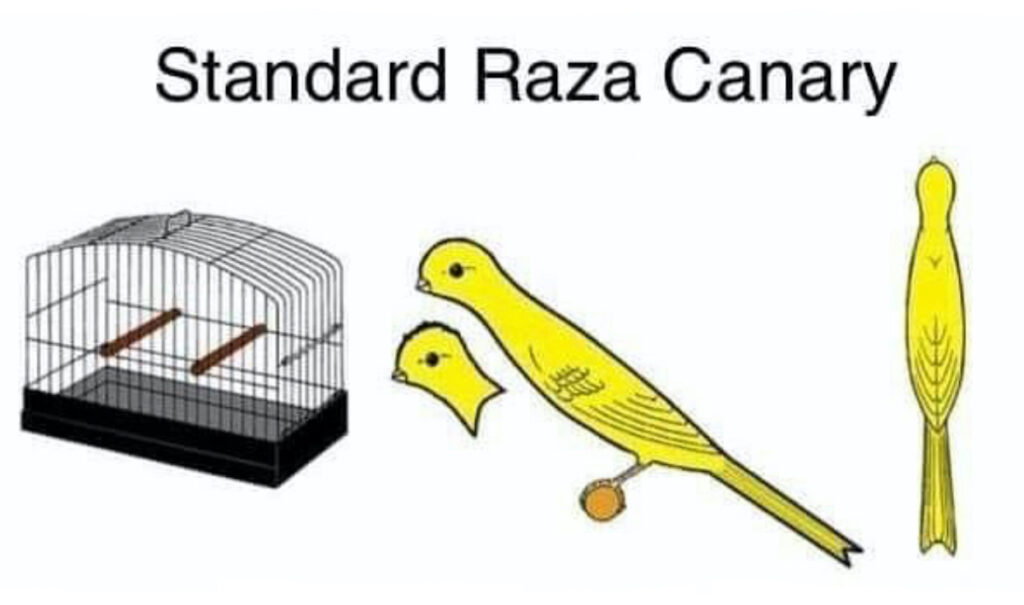A type canary smaller than a Fife? Free-breeding and available in loads of lovely colours? ADAM KENDALL was intrigued enough to acquire some Razas from the UK’s top man
“WHAT on earth are those?” asked Sharon as I skipped into the shed with several pairs of our new breed. With our family, the running joke is: what will be the next bird I happen to cast my eye over and then run full steam into keeping, ultimately immersing the family and the stud alike? Cardinals, azure tits and rosefinches are only a few of the breeds I hope to have. More realistically, the Raza was a good new breed to start with.
Being a Fife breeder first and foremost but having a few show cages spare, it was after seeing the Raza properly for the first time at the 2022 National Exhibition that I thought they’d make an exciting challenge. That year the winner of the Raza section was exhibited by my friend Fernando Higueras. His birds were small – in fact, incredibly small compared to the other Razas in the show, let alone the other varieties. They were in Dewar show cages, which of course I’m used to seeing and using. I found it incredible that even with the bird’s miniaturisation, it commanded the cage – although initially it almost seems to be waiting for an opportunity to escape given its stature. The bird that won was the start of my interest. Its position at 45 degrees was perfect. And I had never seen such a small canary.
Having observed these birds on a number of occasions, I asked Fernando if I could acquire some birds to begin this new venture in 2023. Nobody who knows Fernando will be surprised that he was happy to oblige and furnished me with some very good stock and as much information as I asked for.
This article certainly isn’t “how to do it with Razas”. I’m very much a novice showing as a champion. With this breed I am an absolute novice and I hope in time to learn more about it, especially the colours you can breed – which is a vast range in a variety that’s growing ever more popular.
Now you might read that and think: “But it’s an old and rare variety. It can’t be that popular.” That is true in the UK, but at this year’s World Show you could see how popular it has grown in Europe – and social media groups signal that it could go the same way in the UK. There’s no doubt that most of the leading breeders are from Spain and perhaps Italy, but quality birds are being bred here, too. In time, I can see this bird featuring in its hundreds on the show bench at UK shows, because of its appealing nature in the cage and its free breeding.

Check that posture: the Raza standard
Five for a start
As many people will tell you, the problem with having multiple breeds is keeping your eye on what each one needs, what you are aiming to achieve through your pairings – and then having the time to select and train them in different ways, should you decided to show them.
In the 2023 season we didn’t actually pull up many trees: five chicks bred. My problem was the cocks being overly aggressive while trying to move the best ones around more hens. That has worked so well for us in Fifes, so it had to work in Razas? Surely?
Er, no, it didn’t. And with various fanciers relating to me how easy these birds were to breed, there I was struggling to contain the cocks’ aggression – resulting inevitably in a poor season, given the number of hens I’d retained.
So those five Razas bred in 2023: they were minuscule even compared to Fifes and the smallest breed we keep (common redpolls). I set up the Fife cages with tape over the drinker hole and some use of cable ties, and began the show training.
The biggest surprise is that they are incredibly steady birds from the off – arguably steadier than Fifes. They were very easy to train over a very short period. You’d think being so small they would be flighty, almost finch-like, but they are not. They hold their position very well, even in the first few outings of cage training.
Now as I write – and I’m happy to be corrected – the Raza canary hasn’t got a governing body in the UK, so its classes fall within the old and rare section of most shows and seemingly are catered for by this specialist section.
Keeping, as I do, more traditional breeds and also breeds that conform to traditional colour types, I was flabbergasted on the different colours bred with Razas, as I’ve said. I hope to offer a fuller guide to this – but it appears there’s a neverending range to inspire interest in both type and colour for the Raza. My personal favourite is the jaspe mutation over a dark bird. It has truly spectacular colouring and makes the most striking feather colours.
So out of my five hopeful birds to be shown, I was pleased with two that showed – relatively – enough style that I felt might not have me laughed out of the section. The problem was the colour. I thought quite proudly I had bred two blue hens. What I actually discovered was they were in fact ivory – a pale version of the yellow ground – and I would have wronged-classed them if I had not had help.
Find more news and articles like this on the Cage & Aviary Birds website. Subscribe to Cage & Aviary Birds magazine now.


